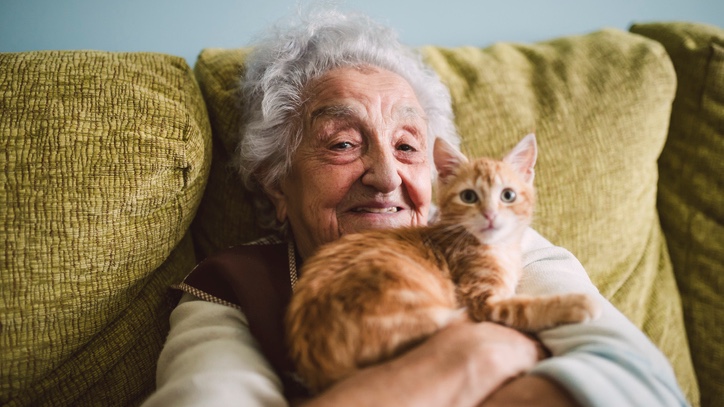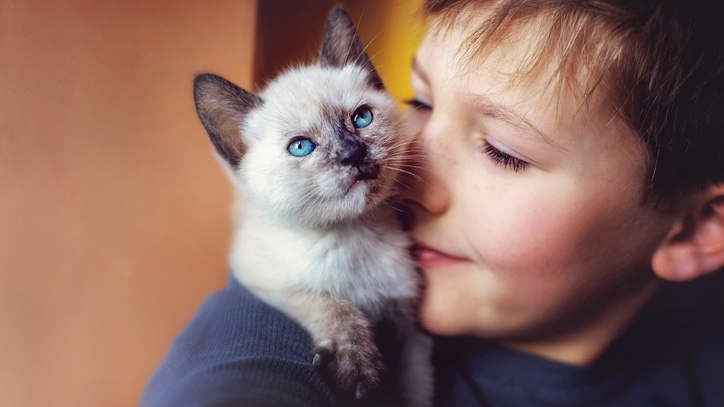How to convert cat years to human years
Understanding how to convert cat years to human years requires a little bit of math - or a handy chart!

When working out how to convert cat years to human years, many people have simply taken a moggy's age and multiplied it by seven.
But there's a teeny weeny problem in doing that: if you look at the list of the 10 oldest cats ever to have lived, you'll find a Texan called Crème Puff who remained alive for a staggering 38 years and three days - and that would work out at 266-human-years-old.
Born in 1967 and dying in 2005, Crème Puff was by no means unique either. Although she earned herself an entry in the Guinness World Records, another American cat called Baby fell just short of beating the entry three years later, while a British moggy named Puss who died in 1939 was recorded as living for 36 years and one day.
All of which means, under the seven-year rule, that these cats would have far, far outstripped the lives of humans who, according to the UN, have a global life expectancy of 72.6 years. So do we really believe that cats can live to such great equivalence? Most likely not.
For while we joke that cats have nine lives, unless they’re stacking them up one after another, it does sound a tad implausible. Yet if we’re not able to simply multiply by seven, is there some other calculation we can make? In other words, does this article even stand up? Quick answer? Yes.
Can you convert cat years to human years?
If we're dismissing the seven-year rule, where does that leave us – other than wondering if feeding our moggies the best cat food could be the secret to a long life? Well, in general, a cat will live for between 12 and 14 years with some continuing for longer. So are we content in saying a year of a cat's life is equal to a year of a human's? Actually, no, we're not.
It is absolutely possible to convert cat years to human years and we have the American Animal Hospital Association to thank for this. In a 16-page paper, researchers laid out a set of guidelines showing the different life stages of our feline friends. And the results may surprise you.
Get the best advice, tips and top tech for your beloved Pets
The first year of a cat's life is actually equal to 15 years of a human's. In other words, they whizz into their teenage years within 12 months, albeit without being quite so stroppy.
But you don’t just multiply a cat’s age by 15. No: the rate of ageing then slows so, by the time they are two-years-old, cats are the equivalent of a 24-year-old person - adding an extra nine years. But what happens after that?
Well, from that moment on, each cat year becomes equivalent to just four human years. So you can take a cat's human age when they're two-years-old (that is, 24) and then add four for every subsequent cat year.
For example, a three-year-old cat will be the equivalent of 28 human years (24 + 4), a four-year-old cat will be the equivalent of 32 years (24 + 4 + 4) and so on. And yes, if you wanted to work out how old you’d be if you were a cat, you could just do the math in reverse!
So how old is my cat in human years?

The easiest way to work this out is to put your calculator down, stop counting on your fingers and instead refer to the chart below. Simply look for your cat's age in the first column and discover the equivalent in the second column (and if you're not quite sure how old your moggy is, learn how to tell a cat’s age first).
Before you do so, however, bear in mind that the age of your cat will be affected by factors such as their breed, weight and whether they're indoor-only or allowed outside. But, in general, you'll be on the right lines here.
| Cat age | Human equivalent |
| 1 month | 1 year |
| 6 months | 10 years |
| 12 months | 15 years |
| 18 months | 21 years |
| 2 years | 24 years |
| 3 years | 28 years |
| 4 years | 32 years |
| 5 years | 36 years |
| 6 years | 40 years |
| 7 years | 44 years |
| 8 years | 48 years |
| 9 years | 52 years |
| 10 years | 56 years |
| 11 years | 60 years |
| 12 years | 64 years |
| 13 years | 68 years |
| 14 years | 72 years |
| 15 years | 76 years |
| 16 years | 80 years |
| 17 years | 84 years |
| 18 years | 88 years |
| 19 years | 92 years |
| 20 years | 96 years |
What are the benefits of converting cat years to human years?
In other words, why bother? Well, aside from satiating your curiosity – who doesn't want to know how old their cat is compared to themselves? – converting cat years to human years will give you a better understanding of your felines and their behaviour.
If you know your 11-year-old cat is 60-human-years-old, for instance, then you're far less likely to expect him or her to be a bundle of energy. You're also going to be more aware of potential health issues. A cat at this age is no spring chicken, after all.
Take Crème Puff, who, as it turns out, was the equivalent of a 168-year-old human (96 years less than under the seven-year rule, incidentally). Faced with such facts, you'd be rushing to buy this moggy the best luxury cat bed and you'd be likely pondering, “what should I feed my older cat?”
In short, it's all about gaining a better understanding of a cat's personality and needs. And it’s a heap of fun too.
Now that you know how to figure out your cat’s age in human years, learn how to keep them happy and healthy well into their senior years with our guide to why cat play is so important.

David Crookes has been a journalist for almost 30 years and he has written for a host of magazines, newspapers, websites and books including the World of Animals Annual, BBC Earth, Live Science, The Independent and Tom’s Guide.
Born in England, he lives with two cats but he’s also keenly interested in the differences between the huge number of dog breeds – in fact, you can read many of his breed guides that he’s written in collaboration with vets here on PetsRadar.
With a lifelong passion for technology, too, he’s always on the lookout for useful devices that will allow people to keep their pets happier and healthier, and provide them more time to spend together.
David has a degree from Durham University, as well as postgraduate diploma in journalism from the University of Central Lancashire.
